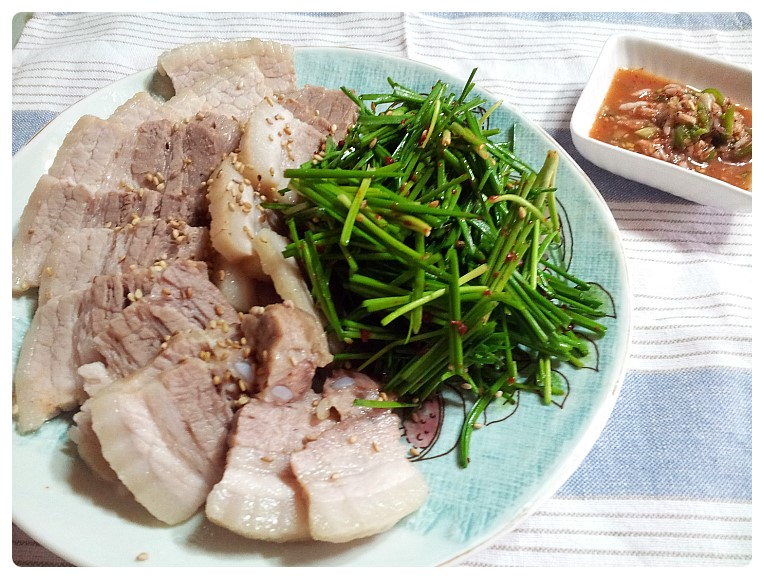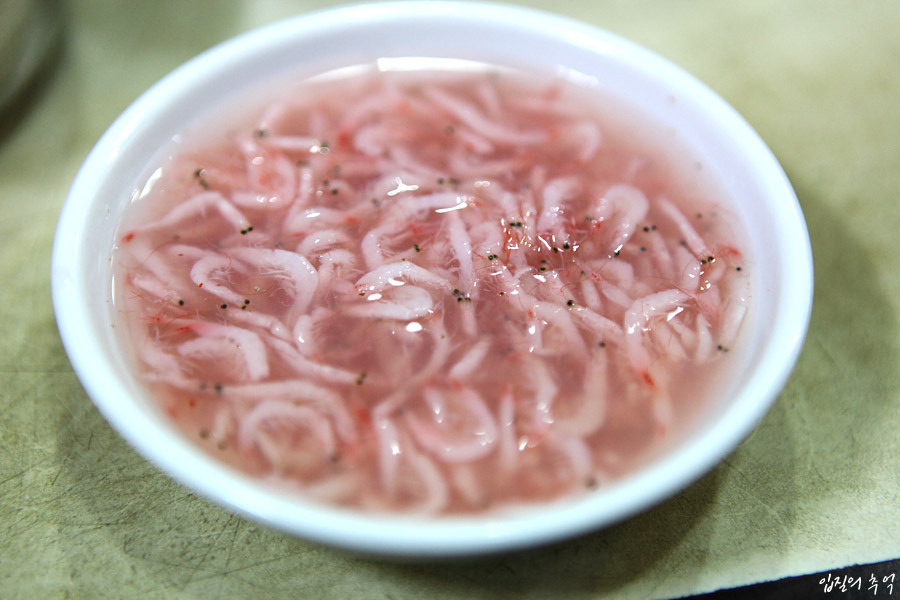Many a time we think we are different from others, but after taking a closer look, we are not as special as we think we are. We're all human after all.
So one of my assignment was on cincaluk. And as I was searching for information online, I got distracted by this video. Look at the condiment at 1:24. Looks familiar? It does, for me. Especially when it's all I see these past two days. Cincalok!!! But wait a second, 새 우 젓 (saewoo jeot)? hmm, Korean?! I was really surprised.
It's not news to me that South east Asian region shared similar dishes/condiments etc, or the East Asian countries claiming origin of certain food. Often time you heard of Malaysian and Indonesian fighting over rendang, satay. And then other times you get confused with kimbap and maki sushi. But similarity between Malaysian food and Korean food, it just never came across my mind.
That being said, I was soon drifted away, from researching cincalok to researching saewoo jeot. *Screw assignment.
 |
| Top: saewoo jeot; bottom: cincalok. See? It looks really similar right? |
After some readings on wikipedia, 새우젓 (saewoo jeot), is a kind of salted and fermented shrimps (새우=shrimps, 젓= salted fermented food ). It is usually used as an ingredient for kimchi. The shrimps that is used for the making of saewoo jeot is literally called 젓새우 (jeot saewoo, shrimps for jeot), while the shrimps used in cincalok is of Acetes sp., or commonly known as udang geragau in Malay. Uncle Wiki told me that Acetes sp. belongs to the family of Sergestidae, which is a branch of superfamily Sergestoidea, of which jeot saewoo belongs to. No wonder they look alike. Ah biology, it's been a while. ><
But if you take a closer look into the two pictures above, you can see that the colour is slightly different, as well as the shape of the shrimps. That's because of the way they are fermented.
 |
Source: Huda, N. (2012). Malaysian Fermented Fish Product. In
Y. Hui, Handbook of animal-based fermented food and beverage technology
(pp. 713). Florida: CRC Press.
|
So, cincalok is fermented with 20% of salt and 6% of rice for 20-30 days, while saewoo jeot is fermented with 15-35% of salt to various degree according to the season and time of the year. (The fermented shrimps are also called differently depending on the month it is fermented.) Obviously, cincalok with added rice had a higher rate of fermentation since it has more 'fuel' (carbohydrates) for anaerobic respiration. If you notice, red colouring is also added to cincalok, which explains the more reddish and less purplish tone.
After understanding how it's made, I realised the difference between these two condiments are just in the rice. But how about it's application? How big a difference does the rice bring to the food? While we all know cincalok is salty, umami, and has a strong fermented rotten-like taste, saewoo jeot according to the video seems to be only salty. Cincalok are usually made into sambal cincalok, with chilli, lime, and shallot, or fried with egg or made into fried rice. Saewoo jeot, on the other hand, is known to be a condiment in stews or stir-fried with zucchini other than a condiment in kimchi.
 |
| Stir-fried zucchini with saewoo jeot ( 애호박채 새우젓 볶음) |
 |
| Saewoo jeot tofu stew (새우젓 두부찌개) |
And then I stumbled on this forum, where this netizen asked if there are other ways to include saewoo jeot into dishes. This one reply suggested to make into a condiment by seasoning it with chilli powder, pepper, garlic, sesame seeds, chilli slices, spring onion and lime/lemon juice. Hmm, it does sound like sambal cincalok, no? Then, there's also steam egg, also similar to our cincalok fried egg/steam egg.
 |
saewoo jeot steam egg (새우젓 달걀찜)
|
 |
| cincalok omelette |
But what caught my attention was accompanying it with three layer pork/pork trotter! Be it stir-fried or just plain! Ah, how could I miss such a classic combination! The last time I eat this was years ago, now I feel like buying a slab of three layer pork to go with cincalok for tomorrow's dinner. =d
 |
such a simple dish, but the tastiness is really off the chart!!!
The condiment on the top right corner is the Korean version of 'sambal cincalok'.
|
 |
| Ready-to-eat sambal cincalok I got from Cold Storage for my research. |
It seemed like these two condiments can be used interchangeably, as this site suggested. It made me curious about the taste of saewoo jeot. Any idea how can get hold of these? I want to try.
Aish, another hour spent on non-assignment-related stuff means an hour lost on assignment. I'd better sign off now before I lose more time. >.<
For the new knowledge I gained today, peace!
Dong







My bottle of cincalok was noticeably actively fermenting after I opened it and I could see tiny bubbles rushing towards the top. Similar to ami no shiokara. Very good on hot rice. I'm Japanese and like to make ika no shiokara (fermented squid). So anything fishy, smelly, with veggies or not are a favorite. Lacto-fermenting some ginger right now. Want to ferment some shirasu (white bait). They are tiny little anchovies about the size of the baby shrimp. Should get a similar result. Might do that today. Thanks for this post! Yes, it's interesting to see how many similarities there are in Asian foods.
ReplyDelete~Chieko
Do you know that during the world war 2, many korean men are sent as Japanese Red Army, hence the similarities of food
ReplyDeletehello..having to say both cincalok and saewoo jot are the similar..can i make kimchi using cincalok as a substitute to saewoo jot ??
ReplyDeleteYes i made kimchi with that and the taste is amazing!
Delete"Cincalok are usually made into sambal cincalok, with chilli, lime, and shallot, or fried with egg or made into fried rice. Saewoo jeot, on the other hand, is known to be a condiment in stews or stir-fried with zucchini other than a condiment in kimchi."
ReplyDeleteslight correction, where i come in malaysia (melaka), cincalok is commonly used as a condiment... especially paired with pork belly
hey, thank you so much for writing about this. this is probably the only post about cincalok vs saweoo jeot. I'm gonna try using the cincalok i have in place of the saewoo jeot in the kimchi, thanks!
ReplyDeleteYou forgot something, cincalok, rusip etc although found in Indonesia, it is hakka food. Korean food shares similarities with hakka food. Even korean samgyetang is similar with hakka stuffed chicken with glutinous rice.
ReplyDelete